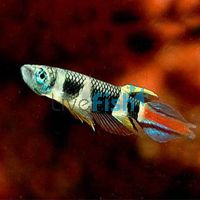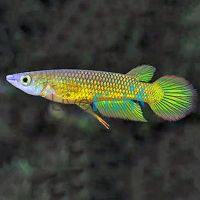Killifish are part of the tooth carp family, however they are egg layers unlike most of the tooth carp family which give birth to live young. Killifish are a fairly diverse and quite rare fish that have adapted to freshwaters around the globe and on occasion some marine waters. They feature spectacular colours, vivid patterns and lengths up to 5 to 10 cm (2 – 4”).
Killifish Care
Killifish are a very hardy and low maintenance fish, as evidenced by their vastly different habitats. That said, co-habitation can be challenging and should be left to the more advanced aquarists. They feature elongated bodies and upturned mouths which they use to hunt live insects on the surface of their waterways. They are also renowned for leaping out of the water as they do in the wild, so a good tank lid is an absolute must for this species. Killifish are usually sold under their Latin names, with some of our most popular species including Aphyosemion Striatum , Aphyosemion Gardneri , Aphyosemion Gardneri Nigerianum and Giant Gold Panchax.
Natural Habitat
Killifish can be found in the wild all over the globe except Australia and Antarctica. They are most commonly found in shallow tropical and sub-tropical freshwaters. There are actually two very different groups of killifish found in the wild; annual and non-annual. Annual killifish are found in small puddles and rice paddies and have a life cycle of only a few months in which they bury their eggs and die when the water levels drop. The eggs then lie in wait for the next rains and hatch, completing the cycle. Annual killifish are particularly rare in fish shops for this reason and are only kept by the most dedicated breeders. Non-annual killifish have far longer lifespans of many years, but grow far slower than their annual counterparts. These fish are found in rivers, dams, streams and even brackish and saltwater environments.

Behavior/Compatibility for Killifish
While killifish are generally quite peaceful, males may aggressively fight if there are not enough females inhabiting the aquarium. They have even been known to get confused and fight similar-looking male fish of other species. They may also get into the fin-nipping habit, increasing the risk of stress on your other fish. Female killifish are more relaxed than males, but there is a trade-off in their comparatively drab colours. If you are planning on keeping multiple killifish in a shared or solo aquarium, plenty of hiding spots and a ratio of one male to three females is advised to limit the aggression. Be aware of their acrobatic nature and ensure your aquarium has a full lid. Some fish that do particularly well with well-behaved killifish are Neon Tetras , Danios and smaller catfish varieties.
Housing Killifish and Aquarium Fish Tank Set-up Tips
Tank
This section will be referring specifically to larger species of killifish (10 cm/4” max length) such as the Giant Gold Panchax , so for smaller species such as the Clown Panchax just take a step behind for each tank size. Please note that smaller killifish should be kept in small schools (min. 5) with a majority being females. The minimum tank size for larger species is 75 litres (20 gallons) and 52 litres (14 gallons) for smaller species. Longer tanks are much better for killifish than tall aquariums. When keeping multiple killifish always pay attention to the female to male ratio (3:1) to help limit the risk of aggression.
Recommended Max Fish Count Tank Volume 2-4 Killifish 75 litre (20 gallons) 6 Killifish 83 litre (22 gallons) 8 Killifish 95 litre (25 gallons) 10 Killifish 113 litre (30 gallons) Base
For those dedicated to raising annual killifish, a thick peat substrate is a must as the fish will naturally attempt to bury their eggs deep in the substrate. However, for non-annual killifish, the substrate is of little importance. You may select this based solely on your aesthetic preferences or the needs of other species in your tank.
Foliage
If you are keeping multiple male killifish in the one aquarium hiding spots in the form of caves, driftwood and porous rocks are an absolute must. Males have been known to gang up on one weaker male and with no place to seek refuge, they may become extremely stressed. As all killifish enjoy lower light environments floating plants such as hornwort are strongly recommended to dissipate the light from the surface.
Water
As killifish have adapted so successfully to such a wide variety of natural habitats, they can handle a wide range of water conditions. However, they really like a slightly cooler water temperature between 20 – 24 C (68 – 75 F). Depending on your local climate, you may need to install a aquarium water heater to ensure the temperature stays within this range.
Killifish enjoy a pH of around 6 to 8 and a hardness of 5-15 dH. To ensure your pH and hardness are suitable you should invest in a testing kit. A slow to moderate water flow suits them well, and the water should be aerated with a fish tank pump.
Always ensure your water is properly filtered, and regularly change the water (10% weekly or 25% every other week). You should also filter the substrate regularly and adjust the chemistry of any tap water you use to top your tank. You may do this with one of our many water conditioning products.
As always, be sure to check the individual needs of your preferred species of killifish to ensure they will be compatible with your tank setup.
Feeding and Care
Killifish are insectivores and subsequently love live feedings. Mosquito larvae, bloodworms, brine shrimp and fruit flies are ideal. You will probably find they reject most pellet and flake foods. One thing important to note is although they might show a particular preference for a live food you should mix it up to ensure your Killifish get all the required nutrients. Please see our wide selection of fish food options to find something suitable for your killifish.
Great reasons to keep Killifish in your tropical fish tank
- • They display absolutely gorgeous colours and a variety of fin shapes.
- • They are a great challenge for more advanced collectors and a good intro to even more difficult species.
- • Due to their rarity a healthy Killifish will make a great conversation piece among other aquarium enthusiasts.
Killifish can make wonderful fish pets and will take your aquarist skills to the next level if properly taken care of. Check out our range of killifish including Aphyosemion striatum , Aphyosemion Gardneri , Aphyosemion Gardneri Nigerianum and Giant Gold Panchax for expedited delivery directly to your door.







